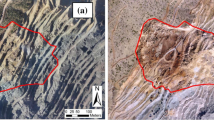Abstract
Stability of slope in an opencast mine is always associated with safety and economics. The steeper slope is always preferred from economic point of view but prone to failure, whereas flatter slopes are uneconomical. A proper understanding of slope which will be a steep enough to be stable is required for safety, economy, and stability of men and machineries. The Rajapur opencast mine is one of the important mines in terms of good quality coal but has problems of water seepage, fire, and weak overburden materials. The existing coal mine has three working seams which are mostly thick and occur at shallow depths of about 50–60 m. Overall slope angle of the working faces as well as final pit is very steep which leads to failures. In the present paper, an attempt has been made to characterize the materials of the mine for simulation of existing slopes. The rock samples from the coal measures were collected to determine the petrophysical characteristics of various rock units. All the pertinent geological parameters from the exposed face were also collected during field visit to assess the slope mass rating (SMR). A two-dimensional finite difference tool was employed to simulate the existing slope geometry as well as relevant parameters of the rock units. The numerical simulation indicates various vulnerable points which are prone to failure as well as displacements at various points along the slope. The results of simulations are corroborated with the SMR value. The results are well matching with the field condition.









Similar content being viewed by others
References
Bieniawski ZT (1974) Geomechanics classification of rock masses and its application in tunneling. Proc. Third Int. Congress on Rock Mech. ISRM, Denver, pp 27–32
Bieniawski ZT (1984) Rock mechanics design in mining and tunneling. A. A. Balkema, Rotterdam, pp 97–133
Chang YL, Huang TK (2005) Slope stability analysis using strength reduction technique. Jl Chin Inst Eng 28(2):231–240
Cundall P (1976) Explicit finite difference methods in geomechanics in numerical methods in engineering. Proc EF Conf Num Meth Geomech 1:132–150
Dasgupta P (2006) Facies characteristics of Talchir Formation, Jharia Basin, India: implications for initiation of Gondwana sedimentation. Sediment Geol 185:59–78
Dawson EM, Roth WH, Drescher A (1999) Slope stability analysis by strength reduction. Geotechnique 49(6):835–840
Dutta P (2002) Gondwana lithostratigraphy of peninsular India. Gondwana Research (GNL Section) 5:540–553
Geological report of Rajapur Open Cast Project (2007)
ISRM (1972) Suggested method for determining water content, porosity, density, absorption and related properties and swelling and slake durability index properties. Int Jl Rock Mech Min Sci Geomech Abstr, pp. 1–12
ISRM (1978a) Commission on Standardization of Laboratory and Field Tests, Suggested methods for the quantitative description of discontinuities in rock masses. Int Jl Rock Mech Min Sci Geomech Abstr 15:319–368
ISRM (1978b) Commission on testing methods, suggested methods for determining the tensile strength of rock materials. Int Jl Rock Mech Min Sci Geomech Abs 15:99–103
ISRM (1981) Rock characterization testing and monitoring, ISRM suggested methods, Int Soc for Rock Mech., pp. 211
Itasca Consulting Group (1995) FLAC/Slope users’ guide, command reference. FISH and Theory and Background, Minneapolis
Janbu N (1967) Discussion of dimensionless parameter for homogeneous Earth slope. Proc ASCE J Soil Mech And found Eng Div 93(6):367–374, Proc Paper 5545, Nov
Kalani E (1975) The rock slope stability problem and application of two dimensional finite elements, V.1, pp. 11–40
Olivera R (1993) The engineering geology of the weak rock. Eng Group geol Soc Spec Publ 8:5–15
Palmstrom A (1982) The volumetric joint count—a useful and simple measure of the degree of rock mass jointing. Proc 4th Conf Int Assoc Eng Geol 5:221–228
Romana M (1985) New adjustment ratings for application of Bieniawaski classification to slopes. Int Symp on the role of rock mech, ISRM. Zacatecas, pp. 49–53
Singh TN, Monjezi M (2000) Slope stability study in jointed rockmass—a numerical approach. Min Engg Jl 1(10):12–13
Vishal V, Pradhan SP, Singh TN (2010) Instability assessment of mine slope—a finite element approach. Int Jl Earth Sci Engg 3:11–23
Author information
Authors and Affiliations
Corresponding author
Rights and permissions
About this article
Cite this article
Singh, T.N., Pradhan, S.P. & Vishal, V. Stability of slopes in a fire-prone mine in Jharia Coalfield, India. Arab J Geosci 6, 419–427 (2013). https://doi.org/10.1007/s12517-011-0341-4
Received:
Accepted:
Published:
Issue Date:
DOI: https://doi.org/10.1007/s12517-011-0341-4




